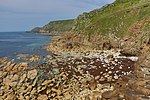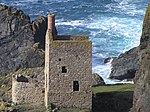Cape Cornwall Mine
Industrial archaeological sites in CornwallPenwithSt Just in PenwithTin mines in CornwallUse British English from February 2023

Cape Cornwall Mine was a tin mine on Cape Cornwall, a cape at the western tip of Cornwall, England, United Kingdom. It operated intermittently between 1838 and 1883, after which time it closed permanently and the engine house was demolished. The mine's 1864 chimney near the peak of the cape was retained as an aid to navigation, and in the early 20th century the former ore dressing floors were for a time converted into greenhouses and wineries. In 1987 the site was donated to the nation by the H. J. Heinz Company. The remains of Cape Cornwall Mine now form part of the Cornwall and West Devon Mining Landscape, a UNESCO World Heritage Site.
Excerpt from the Wikipedia article Cape Cornwall Mine (License: CC BY-SA 3.0, Authors, Images).Cape Cornwall Mine
Cape Cornwall Road,
Geographical coordinates (GPS) Address Nearby Places Show on map
Geographical coordinates (GPS)
| Latitude | Longitude |
|---|---|
| N 50.126944444444 ° | E -5.7091666666667 ° |
Address
Cape Cornwall
Cape Cornwall Road
TR19 7NJ
England, United Kingdom
Open on Google Maps










